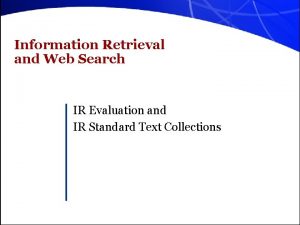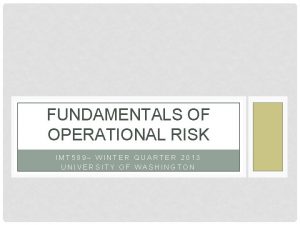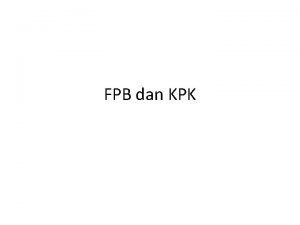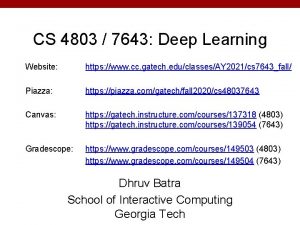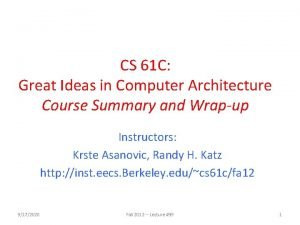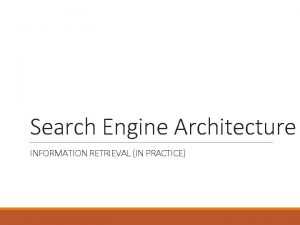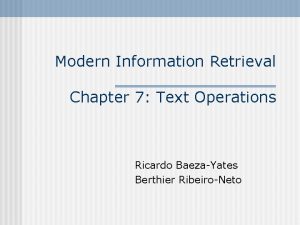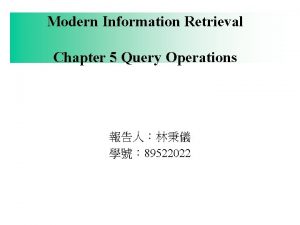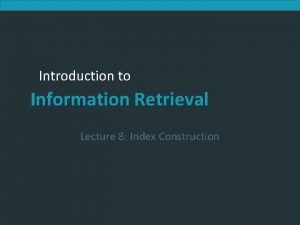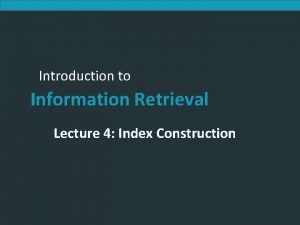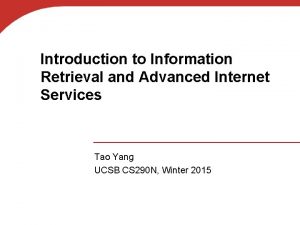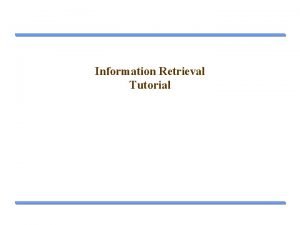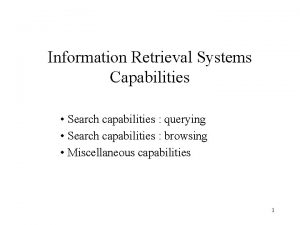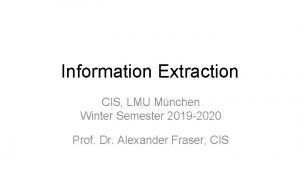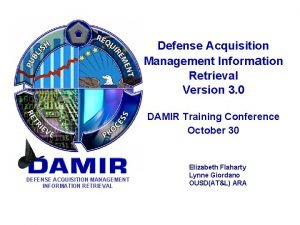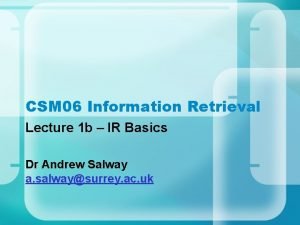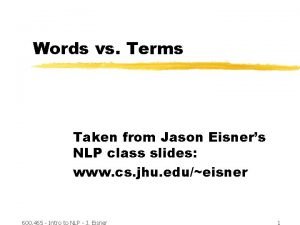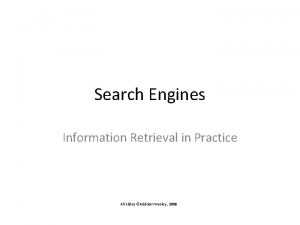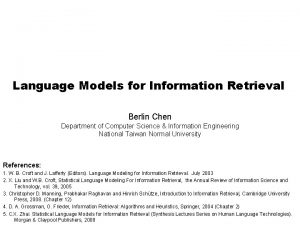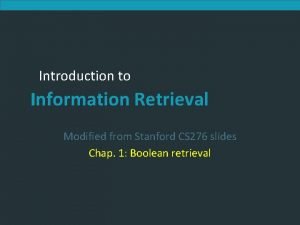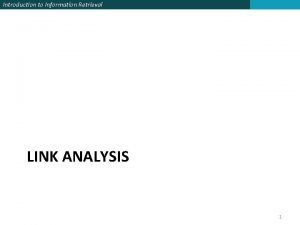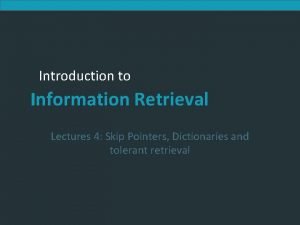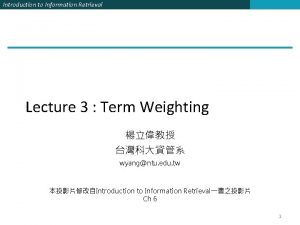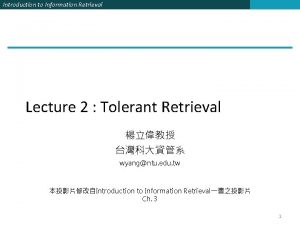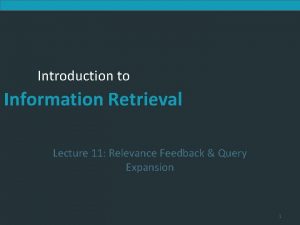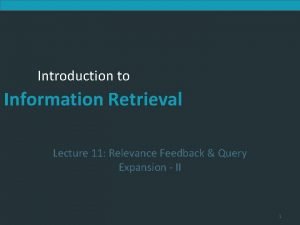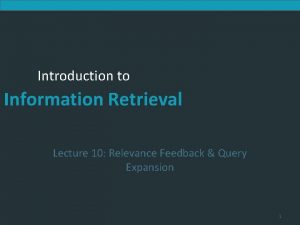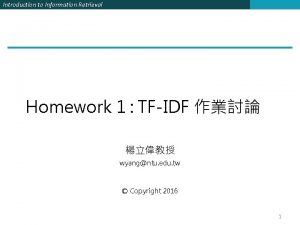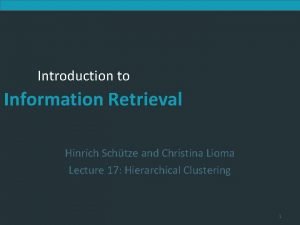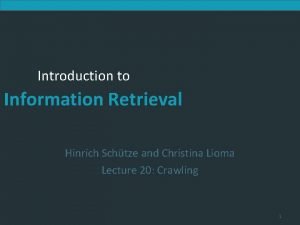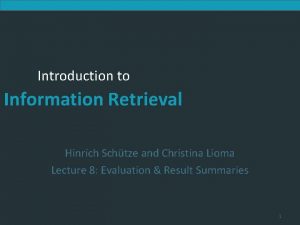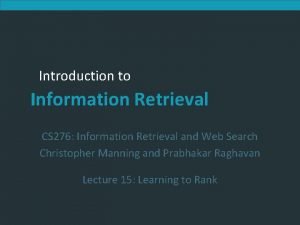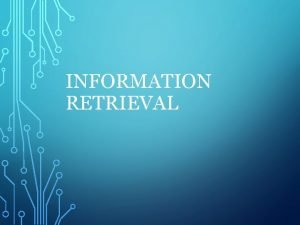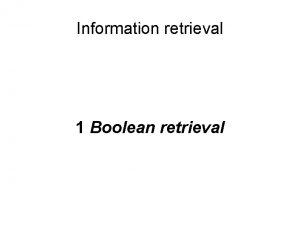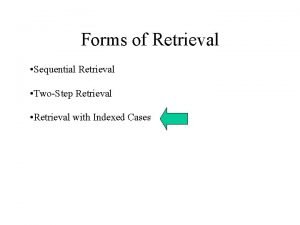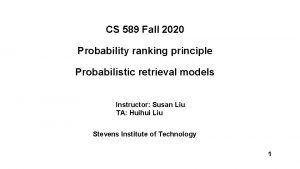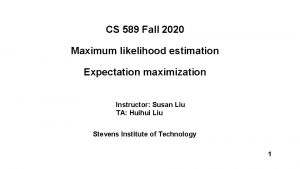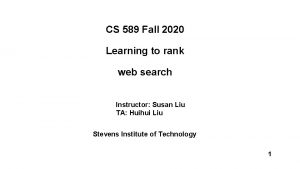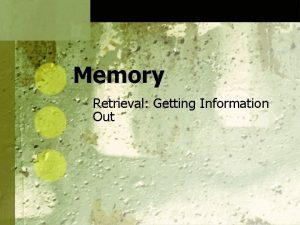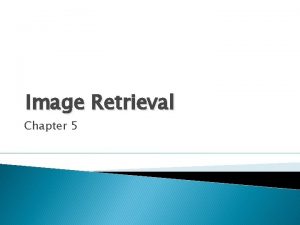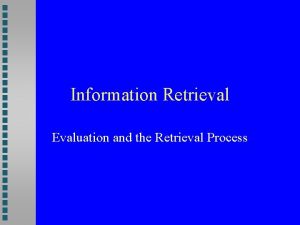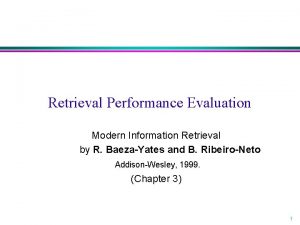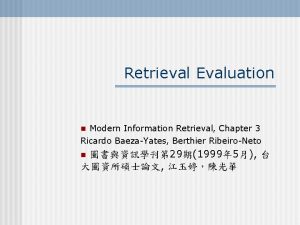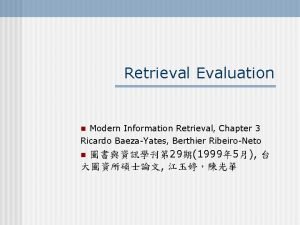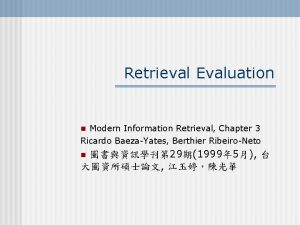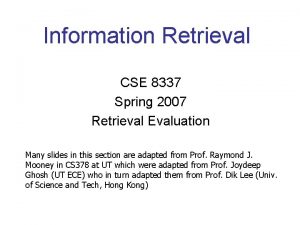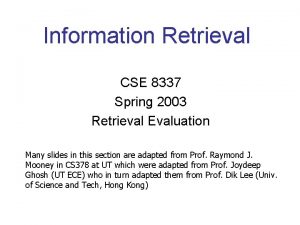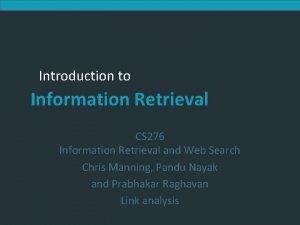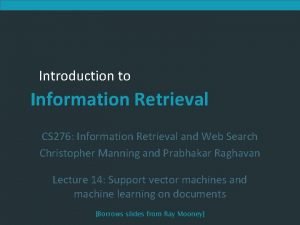CS 589 Fall 2020 Information Retrieval Evaluation Retrieval

























![Position bias [Craswell 08] • Position bias • Higher position receives more attention • Position bias [Craswell 08] • Position bias • Higher position receives more attention •](https://slidetodoc.com/presentation_image_h2/bbabd9fb79010da75456732b50f92bbb/image-26.jpg)












- Slides: 38

CS 589 Fall 2020 Information Retrieval Evaluation Retrieval Feedback Instructor: Susan Liu TA: Huihui Liu Stevens Institute of Technology 1

Information retrievaluation • Last lecture: basic ingredients for building a document search engine • You graduate and join Bing Beat Google! 2

Information retrievaluation • How to know • If your search engine has outperformed another search engine • If your search engine performance has improved compared to last quarter? Beat Amazon! 3

Metrics for a good search engine • Return what the users are looking for • Relevance, CTR = click thru rate • Return results fast • Latency • Users likes to come back • Retention rate 4

Rank-based measurements • Binary relevance • Precision@K • Mean average precision (MAP) • Mean reciprocal rank (MRR) • Multiple levels of relevance • Normalized discounted cumulative gain (NDCG) 5

Precision of retrieved documents • Fraction of retrieved docs that are relevant • Fraction of relevant documents that are retrieved 6

Precision-recall curve Precision + + – – 1/1 2/2 (1/1 + 2/2 + 3/5 + 4/8) / 4 Recall 1/4 2/4 3/5 3/4 4/8 4/4 Precision 1. 0 0. 6 precision usually decreases (not always) 0. 1 0. 2 0. 3 …. 1. 0 Recall Slides from UIUC CS 598 7

Average precision ▪ Consider rank position of each relevant and retrieved doc ▪ K 1, K 2, … K R ▪ Compute Precision@K for K = K 1, K 2, … KR ▪ Average precision: # retrieved documents 8 # relevant documents, not # retrieved documents

MAP Suppose there are 5 relevant documents for both query 1 and 2 This value = #relevant documents, not # retrieved relevant documents (why? ) 9 Slides from Stanford CS 276

Mean reciprocal rank • Measure the effectiveness of the ranked results • Assume users are only looking for one relevant document RR = 1. 0 / (1. 0 + rank_1) p starts from 0 10 Slides from UVA CS 4780

Beyond binary relevance • Discounted cumulative gain (DCG) ▪ Popular measure for evaluating web search and related tasks ▪ Information gain-based evaluation (economics) ▪ For each relevant document, the user has gained some information ▪ The higher the relevance, the higher gain ▪ The gain is discounted when the relevant document appears in a lower position 11

Discounted cumulative gain (DCG) 2 0 1 2 2 1 0 0 0 2 0 0 1 2 2 0 1 2 p starts from 1 12

Why normalizing DCG? • If we do not normalize DCG, the performance will be biased towards systems that perform well on queries with larger DCG scales system A “TV” system B DCG=4. 79 DCG=5. 79 DCG=1. 89 DCG=1. 39 avg=3. 34 avg=3. 59 2 0 1 2 2 1 0 0 0 2 “clothing” 0 2 0 0 1 2 2 0 1 2 13 bias towards B

Normalized Discounted cumulative gain (n. DCG) 2 0 1 2 2 1 0 0 0 2 0 0 1 2 2 0 1 2 14

Relevance evaluation methodology • Offline evaluation: • Evaluation based on annotators’ annotation (explicit) • TREC conference • Cranfield experiments • Pooling • Evaluation based on user click through logs (implicit) • Online evaluation • A/B testing 15

Text REtrieval Conference (TREC) • Since 1992, hosted by NIST • Relevance judgment are based on human annotations • The relevance judgment goes beyond keywords matching • Different tracks for TREC • Web • Question answering • Microblog 16

The Cranfield experiment (1958) • Imagine you need to help users search for literatures in a digital library, how would you design such a system? computer science artificial intelligence query = “subject = AI & subject = bioinformatics” bioinformatics system 1: the Boolean retrieval system 17

The Cranfield experiment (1958) • Imagine you need to help users search for literatures in a digital library, how would you design such a system? Document-term matrix Doc 1 Doc 2 query intelligence book the cat 0 1 1 1 0 0 3 0 1 1 0 0 query = “artificial intelligence” artificial dog 0 0 1 1 0 0 business 0 1 0 bags of words representation system 2: indexing documents by lists of words 18

The Cranfield experiment (1958) • Basic ingredients • A corpus of documents (1. 4 k paper abstracts) • A set of 225 queries and their information needs • Binary relevance judgment for each (q, d) pair • Reuse the relevance judgments for each (q, d) pair query = “best phone”, time = 2012, relevance = 1 Nokia query = “best phone”, time = 2022, 19 relevance = 0

Scalability problem in human annotation • TREC contains 225 x 1. 4 k = 315 k (query, documents) pairs • How to annotate so many pairs? • Pooling strategy • For each of K system, first run the system to get top 100 results • Annotate the union of all such documents 20

Evaluation based on user click through logs • TREC style relevance judgment • Explicit relevance judgment • Difficult to achieve large scalability • Relevance is fixed • Relevance judgment using user clicks • Implicit relevance judgment • Effortless relevance judgment at a large scale • Relevance is fixed, (assume relevance judgment stays the same upon reranking) 21

Evaluation based on user click through logs • Click logs for “CIKM” slides from Stanford CS 276 the most relevant document 22

Evaluation based on user click through logs • System logs the users engagement behaviors: • Time stamp • Session id • Query id, query content • Items viewed by the user (in sequential order) • Whether each item has been clicked by the user • User’s demographic information, search/click history, location, device • Dwell time, browsing time for each document • Eye tracking information 23

Evaluation based on user click through logs • Click logs are stored in large tables • Using SQL to extract a subset of query logs 24

Online evaluation methodology • Assumption made by offline evaluation • After reranking, relevance judgment stays the same • Which is not true… • Relevance judgment is dynamic, subject to user bias • Bias based on positions • Preference shifting over time, location • Decoy effects 25
![Position bias Craswell 08 Position bias Higher position receives more attention Position bias [Craswell 08] • Position bias • Higher position receives more attention •](https://slidetodoc.com/presentation_image_h2/bbabd9fb79010da75456732b50f92bbb/image-26.jpg)
Position bias [Craswell 08] • Position bias • Higher position receives more attention • The same item gets lower click in lower position click not click 26

Decoy effects vs $400, 20 G $500, 30 G click probability = 0. 3 click probability = 0. 4 click probability = 0. 5 $550, 20 G 27

Online evaluation methodology • Evaluation by actually having the system deployed and observe user response • Less scalable • A/B testing 28

Interleaving remove dup A clicks = 3, B clicks = 1 29

Online evaluation methodology • Bing has an existing ranking algorithm A • Testing algorithm B is better than A • Strategy 1: Running A of 1 month, running B for the next month • Strategy 2: Running A 50% of the time, B 50% of the time • Disadvantage with Strategy 1 and 2: • If B fails, it will hurts user experience from the B group • Running B 5% of the time, running A 95% of the time 30

Retrieval feedback in session search query = “best phone” Does the user prefer lower priced phone, or high end phones? Larger storage, better camera? $400, 20 G, Nokia $500, 30 G, Nokia session 2 1 $600, 40 G, iphone observed click 33

Rocchio feedback • Feedback for vector-space model rel docs non-rel docs beta >> gamma • Rocchio’s practical issues • Large vocabularies (only consider important words) • Robust and effective • Requires relevance feedback 34

Pseudo-relevance feedback • What if we do not have relevance judgments? • Use the top retrieved documents as “pseudo relevance documents” • Why does pseudo-relevance feedback work? query = “fish tank” 35

Relevance feedback in RSJ model (Robertson & Sparck Jones 76) Probability for a word to appear in a relevant doc Probability for a word to appear in a non-relevant doc 36

(Pseudo)relevance feedback language model sparsity get document model retrieve infer w/ EM algo Model-based feedback in the language modeling approach to information retrieval 37

Performance of relevance feedback models 38

Query expansion 39

Query reformulation • Query expansion/reformulation techniques • Using manually created synonyms • Using automatically derived thesaurus • Using query log mining 40
 Precision and recall in information retrieval
Precision and recall in information retrieval Information retrieval evaluation
Information retrieval evaluation Imt 589
Imt 589 Konsep habis dibagi
Konsep habis dibagi Cs 7643 fall 2020
Cs 7643 fall 2020 Task level parallelism
Task level parallelism Cs61c fall 2020
Cs61c fall 2020 Sequential search
Sequential search Components of search engine in information retrieval
Components of search engine in information retrieval Modern information retrieval
Modern information retrieval Query operations in information retrieval
Query operations in information retrieval For skip pointer more skip leads to
For skip pointer more skip leads to Index construction in information retrieval
Index construction in information retrieval Bsbi vs spimi
Bsbi vs spimi Which internet service is used for information retrieval
Which internet service is used for information retrieval Information retrieval tutorial
Information retrieval tutorial Wildcard query in information retrieval
Wildcard query in information retrieval Capabilities of information retrieval system
Capabilities of information retrieval system Link analysis in information retrieval
Link analysis in information retrieval Information retrieval lmu
Information retrieval lmu Defense acquisition management information retrieval
Defense acquisition management information retrieval Advantages of information retrieval system
Advantages of information retrieval system Information retrieval nlp
Information retrieval nlp Signature file structure in information retrieval system
Signature file structure in information retrieval system Search engines information retrieval in practice
Search engines information retrieval in practice Relevance information retrieval
Relevance information retrieval Stanford information retrieval
Stanford information retrieval Link analysis in information retrieval
Link analysis in information retrieval Which is a good idea for using skip pointers?
Which is a good idea for using skip pointers? Anthony julius
Anthony julius Information retrieval
Information retrieval Information retrieval
Information retrieval Information retrieval
Information retrieval Relevance information retrieval
Relevance information retrieval Information retrieval
Information retrieval Information retrieval
Information retrieval Url image
Url image Information retrieval
Information retrieval Relevance information retrieval
Relevance information retrieval

